AMD Launches EPYC 8004-Series 'Siena' CPUs: Up to 64 Zen 4c Cores
AMD unveils EPYC 8004-series processors for edge servers.
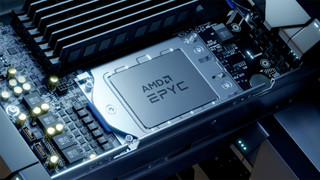
AMD has introduced its EPYC 8004-series processors codenamed Siena. The new CPUs come in an all-new SP6 form-factor, pack up to 64 Zen 4c cores, and feature a six-channel DDR5 memory subsystem. AMD's EPYC 'Siena' processors are designed for edge and communications servers that rely on one processor and require advanced I/O and power efficiency more than raw performance.
"The new EPYC 8004 Series processors extend AMD leadership in single socket platforms by offering excellent CPU energy efficiency in a package tuned to meet the needs of space and power-constrained infrastructure," said Dan McNamara, senior vice president and general manager, Server Business, AMD.
AMD's EPYC 8004-series 'Siena' processors for intelligent edge applications use an all-new SP6 platform, but re-use core components of Bergamo CPUs for high-density servers, such four 16-core Zen 4c general-purpose chiplets as well as I/O die used by the these CPUs. The processor feature from eight to 64 cores clocked at 2.0 – 3.10 GHz and a TDP ranging from 80W to 200W. Meanwhile, it is possible to configure these processors for an up to 225W TDP or reduce their power consumption to 70W.
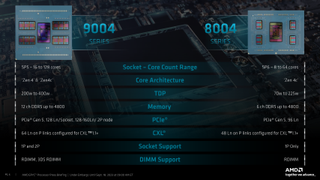
While AMD's Zen 4c are smaller and less power hungry than full-blown Zen 4 cores, they support the same feature set as their larger counterparts and can therefore run applications that rely on instructions like AVX-512. Although AMD's EPYC 9004-series processors deliver higher performance, AMD's EPYC 8004-series CPUs promise a lower total cost of ownership and higher power efficiency. AMD claims that Siena offers an up to 2x better performance per watt compared to competitors (Xeon Platinum 8490H, Xeon Platinum 8471N ) in SPECpower_ssj 2008. Specifically, the EPYC 8324P showcases up to 1.16x better performance per core in video encoding tasks (than Intel's 32-core Xeon 6421N), according to benchmark results conducted by AMD. In IoT Edge gateway workloads, an eight-core EPYC 8024P offers nearly 1.8x the total SPECrate 2017_int_base throughput performance per 8kW rack against an eight-core competitor (Intel's Xeon Platinum 8471N).
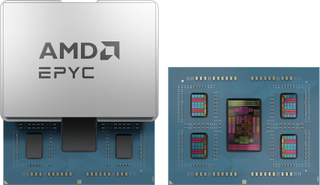
The new AMD EPYC 8004-series processors feature a six-channel DDR5-4800 subsystem that supports up to 1.152 TB of memory. Intelligent edge servers are a relatively new type of application. Some of these machines can take advantage of traditional CPUs, whereas the other pack special-purpose accelerators. That said, modern I/O capabilities is a must for such machines. Therefore, AMD's Siena also support 96 PCIe 5.0 lanes with 48 of them supporting the CXL 1.1+ protocol on top for advanced modern accelerators (for AI inference or other applications) and/or memory expanders.
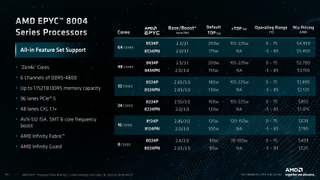
AMD says that its EPYC 8004 'Siena' processors are now available inside new edge servers from Dell (PowerEdge C6615), Lenovo (ThinkEdge SE455 V3), and Supermicro (H13 generation of WIO Servers). The new CPUs are also endorsed by Ericsson and Microsoft Azure.
The launch of AMD's EPYC 8004-series 'Siena' processors completes the company's 4th Generation EPYC portfolio with offerings including general-purpose servers (Genoa), high-performance computing (Genoa-X), cloud native (Bergamo), and intelligent edge (Siena) machines
Stay On the Cutting Edge: Get the Tom's Hardware Newsletter
Get Tom's Hardware's best news and in-depth reviews, straight to your inbox.
"AMD has delivered multiple generations of data center processors that provide outstanding efficiency, performance, and innovative features," added McNamara. "Now with our 4th Gen EPYC CPU portfolio complete, that leadership continues across a broad set of workloads – from enterprise and cloud, to intelligent edge, technical computing and more."
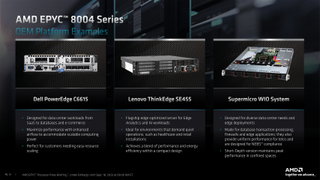

Anton Shilov is a Freelance News Writer at Tom’s Hardware US. Over the past couple of decades, he has covered everything from CPUs and GPUs to supercomputers and from modern process technologies and latest fab tools to high-tech industry trends.
-
bit_user Reply
Well, here's data from CineBench R20. If you compare the two scores for the TR 3990X (4-channel memory) vs. the corresponding scores for the 3995WX (8-channel memory), you can see that it favors clockspeed over memory bandwidth.jaydenmiller1 said:I wonder how these CPUs score in cinebench r23 and 2024?
Source: https://www.anandtech.com/show/16805/amd-threadripper-pro-review-an-upgrade-over-regular-threadripper/3Assuming those newer CB revs behave similarly, the main question is how well it'll fare with half the L3 cache per core. That will probably hurt a lot more than going from 12-channels to 6-chanels. -
Order 66 Reply
what about data from cinebench r23? r20 doesn't tell me much in comparison to my CPU as I have only used r23 and 2024.bit_user said:Well, here's data from CineBench R20. If you compare the two scores for the TR 3990X (4-channel memory) vs. the corresponding scores for the 3995WX (8-channel memory), you can see that it favors clockspeed over memory bandwidth.
Source: https://www.anandtech.com/show/16805/amd-threadripper-pro-review-an-upgrade-over-regular-threadripper/3Assuming those newer CB revs behave similarly, the main question is how well it'll fare with half the L3 cache per core. That will probably hurt a lot more than going from 12-channels to 6-chanels. -
bit_user Since AMD already did all of the work needed to bring this socket to fruition, it might've been nice if they also offered it as a lower-cost HEDT platform than ThreadRipper.Reply -
bit_user Reply
You're on your own, then. I was interested in revisiting what was known about how CineBench responded to a reduction in memory bandwidth @ 64 cores. I've done that. If I knew where such data existed for more recent CB versions, I'd have cited it. I wasn't about to go on a wild goose chase, because I really have no stake in the matter.jaydenmiller1 said:what about data from cinebench r23? r20 doesn't tell me much in comparison to my CPU as I have only used r23 and 2024.
If you find data showing newer CB revisions are more bandwidth (or L3 cache) sensitive, feel free to share it. -
TJ Hooker Reply
Can't you just run r20 on your current CPU for comparison?jaydenmiller1 said:what about data from cinebench r23? r20 doesn't tell me much in comparison to my CPU as I have only used r23 and 2024. -
Order 66 Reply
I could however r23 takes better advantage of multi core cpus. and I would like to see something from Zen 4 get over 30,000 points.TJ Hooker said:Can't you just run r20 on your current CPU for comparison? -
bit_user Reply
The point of my looking up those benchmarks was to see how much CineBench was affected by memory bandwidth. ThreadRipper 3000 vs. ThreadRipper Pro 3000 differed in that Pro had 8-channel memory & slightly lower clock speed, while the non-Pro had 4-channel memory & slightly higher clock speed.TJ Hooker said:Can't you just run r20 on your current CPU for comparison?
The idea was to gauge how CB might fare on a 64-core Zen4C CPU with only 6-channel memory. I don't really see what @jaydenmiller1 's CPU has to do with that question, unless it's some ThreadRipper or EPYC.
However, if that CPU model is popular, then I guess you could go ahead and look for R20 benchmarks of it. Not sure how useful either that or comparing your R23/R24 results with TR 3k would be. The main argument I see for searching out data on the newer benchmarks is if it affects multi-core scalability, but you still need to find essentially the same CPU tested with substantially different memory configurations. -
Order 66 Reply
I will admit, I skimmed your original post and missed the part where the point was to see the difference in memory channels. My CPU is "only" a ryzen 7 7700x. No fancy TR or EPYC here.bit_user said:The point of my looking up those benchmarks was to see how much CineBench was affected by memory bandwidth. ThreadRipper 3000 vs. ThreadRipper Pro 3000 differed in that Pro had 8-channel memory & slightly lower clock speed, while the non-Pro had 4-channel memory & slightly higher clock speed.
The idea was to gauge how CB might fare on a 64-core Zen4C CPU with only 6-channel memory. I don't really see what @jaydenmiller1 's CPU has to do with that question, unless it's some ThreadRipper or EPYC.
However, if that CPU model is popular, then I guess you could go ahead and look for R20 benchmarks of it. Not sure how useful either that or comparing your R23/R24 results with TR 3k would be. The main argument I see for searching out data on the newer benchmarks is if it affects multi-core scalability, but you still need to find essentially the same CPU tested with substantially different memory configurations. -
bit_user Reply
The new CPUs are likely just a matter of curiosity, then? The article includes a price list, so you can see it's unlikely to be much of a cost savings vs. ThreadRipper, if any.jaydenmiller1 said:I will admit, I skimmed your original post and missed the part where the point was to see the difference in memory channels. My CPU is "only" a ryzen 7 7700x. No fancy TR or EPYC here.
I don't even know if AMD will be very receptive to the idea of mainstreaming this platform. Intel has specialty edge/communication-oriented SKUs (allegedly what Siena is targeting) and they're effectively impossible to find on any kind of standard server or PC motherboard. So, if AMD plans to follow that playbook, then Siena could be a mere footnote for the mainstream computing industry.
If I had to guess, I think it'll end up being more like Xeon D, where you actually can use them for other things. Then again, I'm reminded of how scarce Ryzen Pro is, outside of specific OEM systems.